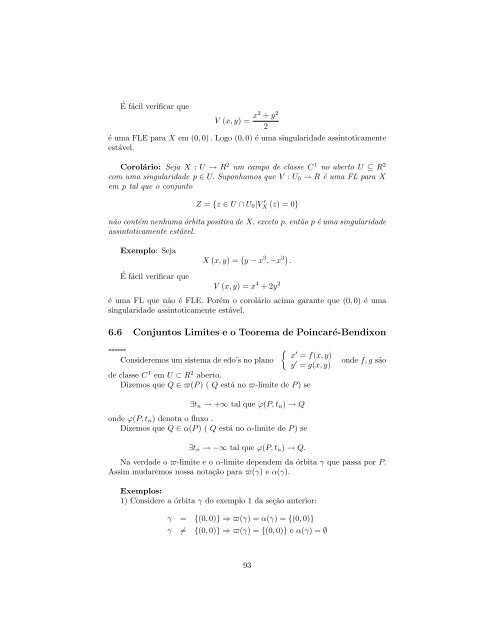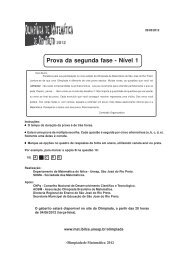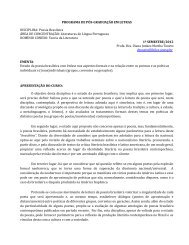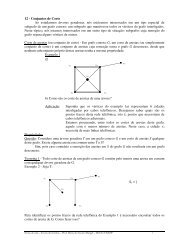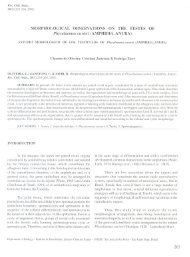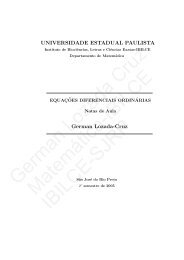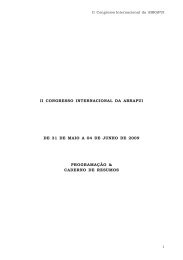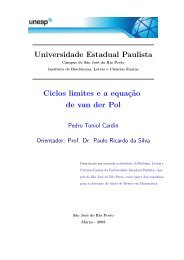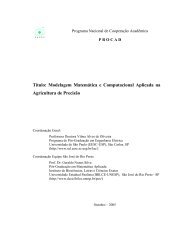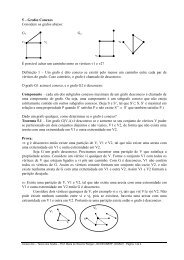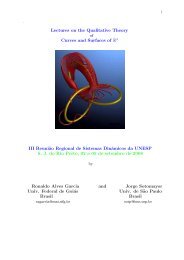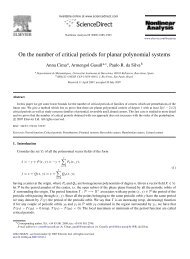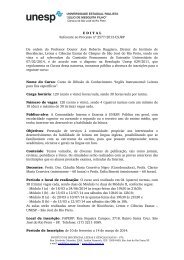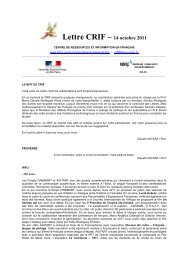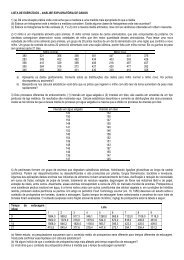Curso de Equações Diferenciais Ordinárias - Unesp
Curso de Equações Diferenciais Ordinárias - Unesp
Curso de Equações Diferenciais Ordinárias - Unesp
You also want an ePaper? Increase the reach of your titles
YUMPU automatically turns print PDFs into web optimized ePapers that Google loves.
É fácil verificar que<br />
V (x, y) = x2 + y 2<br />
2<br />
é uma FLE para X em (0, 0) . Logo (0, 0) é uma singularida<strong>de</strong> assintoticamente<br />
estável.<br />
Corolário: Seja X : U → R 2 um campo <strong>de</strong> classe C 1 no aberto U ⊆ R 2<br />
com uma singularida<strong>de</strong> p ∈ U. Suponhamos que V : U 0 → R é uma FL para X<br />
em p tal que o conjunto<br />
Z = {z ∈ U ∩ U 0 |V ′ X (z) = 0}<br />
não contém nenhuma órbita positiva <strong>de</strong> X, exceto p, então p é uma singularida<strong>de</strong><br />
assintoticamente estável.<br />
Exemplo: Seja<br />
X (x, y) = ( y − x 3 , −x 3) .<br />
É fácil verificar que<br />
V (x, y) = x 4 + 2y 2<br />
é uma FL que não é FLE. Porém o corolário acima garante que (0, 0) é uma<br />
singularida<strong>de</strong> assintoticamente estável.<br />
6.6 Conjuntos Limites e o Teorema <strong>de</strong> Poincaré-Bendixon<br />
{ x<br />
Consi<strong>de</strong>remos um sistema <strong>de</strong> edo’s no plano<br />
′ = f(x, y)<br />
y ′ = g(x, y)<br />
<strong>de</strong> classe C 1 em U ⊂ R 2 aberto.<br />
Dizemos que Q ∈ ϖ(P ) ( Q está no ϖ-limite <strong>de</strong> P ) se<br />
on<strong>de</strong> f, g são<br />
∃t n → +∞ tal que ϕ(P, t n ) → Q<br />
on<strong>de</strong> ϕ(P, t n ) <strong>de</strong>nota o fluxo .<br />
Dizemos que Q ∈ α(P ) ( Q está no α-limite <strong>de</strong> P ) se<br />
∃t n → −∞ tal que ϕ(P, t n ) → Q.<br />
Na verda<strong>de</strong> o ϖ-limite e o α-limite <strong>de</strong>pen<strong>de</strong>m da órbita γ que passa por P.<br />
Assim mudaremos nossa notação para ϖ(γ) e α(γ).<br />
Exemplos:<br />
1) Consi<strong>de</strong>re a órbita γ do exemplo 1 da seção anterior:<br />
γ = {(0, 0)} ⇒ ϖ(γ) = α(γ) = {(0, 0)}<br />
γ ≠ {(0, 0)} ⇒ ϖ(γ) = {(0, 0)} e α(γ) = ∅<br />
93


